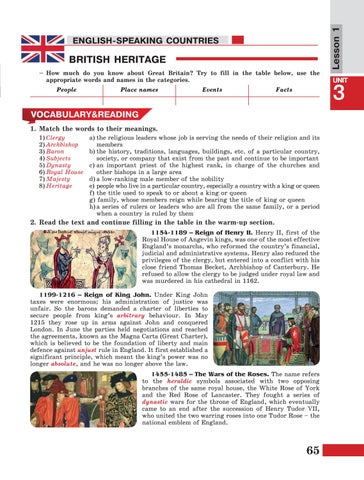BRITISH HERITAGE – How much do you know about Great Britain? Try to fill in the table below, use the appropriate words and names in the categories. People
Place names
Events
Facts
VOCABULARY&READING 1. Match the words to their meanings. 1) Clergy 2) Archbishop 3) Baron 4) Subjects 5) Dynasty 6) Royal House 7) Majesty 8) Heritage
a) the religious leaders whose job is serving the needs of their religion and its members b) the history, traditions, languages, buildings, etc. of a particular country, society, or company that exist from the past and continue to be important c) an important priest of the highest rank, in charge of the churches and other bishops in a large area d) a low-ranking male member of the nobility e) people who live in a particular country, especially a country with a king or queen f) the title used to speak to or about a king or queen g) family, whose members reign while bearing the title of king or queen h) a series of rulers or leaders who are all from the same family, or a period when a country is ruled by them
2. Read the text and continue filling in the table in the warm-up section. 1154-1189 – Reign of Henry II. Henry II, first of the Royal House of Angevin kings, was one of the most effective England’s monarchs, who reformed the country’s financial, judicial and administrative systems. Henry also reduced the privileges of the clergy, but entered into a conflict with his close friend Thomas Becket, Archbishop of Canterbury. He refused to allow the clergy to be judged under royal law and was murdered in his cathedral in 1162. 1199-1216 – Reign of King John. Under King John taxes were enormous; his administration of justice was unfair. So the barons demanded a charter of liberties to secure people from king’s arbitrary behaviour. In May 1215 they rose up in arms against John and conquered London. In June the parties held negotiations and reached the agreements, known as the Magna Carta (Great Charter), which is believed to be the foundation of liberty and main defence against unjust rule in England. It first established a significant principle, which meant the king’s power was no longer absolute, and he was no longer above the law. 1455-1485 – The Wars of the Roses. The name refers to the heraldic symbols associated with two opposing branches of the same royal house, the White Rose of York and the Red Rose of Lancaster. They fought a series of dynastic wars for the throne of England, which eventually came to an end after the succession of Henry Tudor VII, who united the two warring roses into one Tudor Rose – the national emblem of England.
65
Lesson 1
ENGLISH-SPEAKING COUNTRIES ENGLISH-SPEAKING COUNTRIES
UNIT
3






















